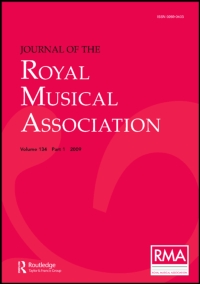No CrossRef data available.
Article contents
Music in the Chapel of King Henry VI
Published online by Cambridge University Press: 01 January 2020
Extract
Used geographically, the title “Chapel of King Henry VI” may naturally turn the mind, especially the musical mind, to King's Chapel at Cambridge; but, as you will have seen from the printed syllabus, I am using the title in the historical sense, as applied to the Chapel of St. George in Windsor Castle, the chapel in which Henry worshipped, and for which he actually wrote music.
- Type
- Research Article
- Information
- Copyright
- Copyright © Royal Musical Association, 1933
References
1 MS. xv 49.26. I have to mention here my grateful thanks to Mr. Lewis Stainton, Chapter Clerk of St. George's, Windsor, for much courteous help in the perusal of the Windsor records.Google Scholar
2 MS. iv b 16.17. The entry is in Book I, page 23.Google Scholar
3 Sammelbände der Internationalen Musikgesellschaft. Jahrgang II (1900–01), p. 342.Google Scholar
4 Westminster Cathedral Chronicle, September, 1916, p. 171.Google Scholar
5 The Old Hall Manuscript. Plainsong and Mediaeval Music Society, vol. I, 1933 (in progress).Google Scholar
6 Strictly speaking, twenty-three; for Dunstable's composition is anonymous here.Google Scholar
7 Oxford History of Music (first edition), vol. II, p. 153.Google Scholar
8 From information kindly supplied by Mr. F. E. E. Harvey, of Cambridge.Google Scholar
9 An old St. Andrew's Music Book (Humphrey Milford, 1931).Google Scholar
10 June, 1932, and August, 1933.Google Scholar
11 Polyphonia Sacra (Plainsong and Mediaeval Music Society, 1932)Google Scholar
12 Cf. Father Lancelot Long in Laudate, June, 1933, p. 103.Google Scholar
13 The Style of Palestrina and the Dissonance. Oxford University Press, 1927.Google Scholar
14 The Evolution of the Six-four Chord. University of California Press (and O.U.P., London), 1933.Google Scholar
15 There is no money in it.Google Scholar
16 The Book of the English Church Pageant, London, 1909. On p. xvi the advisory committee for the music is stated to be H. P. Allen, W. Barclay Squire and R. Vaughan Williams.Google Scholar


